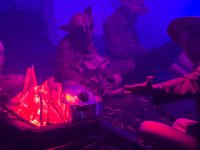Editorial note: This article was originally published in the Knutepunkt 2025 book Anatomy of Larp Thoughts, a breathing corpus. It has been reprinted from there with the editors’ and authors’ permission. It has not been edited by Nordiclarp.org.
In her book of essays Death By Landscape, Elvia Wilk (2022) describes why she decided to adapt the novel she was working on into a larp. She says she was driven by a desire to give the novel a life outside of herself, to “explode” it to see how its characters would change or stay the same (2022, 186), and to see whether there was a happy ending in the story after all, one that she herself had not been able to unravel. I recognize this desire as my own. When I create larps I am often curious to see how players will inhabit the roles that I have scripted, and more specifically, how they pick up or resist the genre conventions many of my larps experiment with. For example, in The Kids Are Not Alright (2023), I was interested to see what would happen when the creepy, horror-movie cliché of the haunted child met the underpaid and overworked social worker who has just stepped out of a Ken Loach film. For the child, monsters are real; for the social worker, evil is systemic. To explore the result of this genre-clash, the game needed to be played.
If larp is a co-creative practice, one that cannot exist without its players, what do we call larps that were never played? And what do we do with them? Can we still give them a life outside of ourselves, and enjoy their unpredictability? As will become apparent, this is a self-serving question that I nevertheless hope will chime with many readers. Who hasn’t had ideas or plans for larps that never came to fruition? Staging a larp is not easy. It requires time, money, access to suitable spaces, as well as a network of players and collaborators. In the Knutepunkt books you can find post-mortems of successful larps as well as practical how-to-guides for budding designers, but there is no discussion of designs that were never realized.
With this article I’d like to start such a discussion, and to do so I turn, again, to Wilk who concludes her essay with another metaphor for the creative process. She argues that rather than explode her novel, what she really did (and continues to do) with the story is compost it, recycling the material and using it “as soil for new seeds” (2022, 192). I like this metaphor. There is value in a good concept; dreaming and ideation are worthwhile. They are like nutrients that need to be kept in circulation, otherwise creative ecosystems get depleted. This is a call to start composting your ideas. I will try to lead by example by composting a solarpunk larp that never got off the ground: ‘The Antarcticans.’ In the block quotes below, you’ll find excerpts from an initial pitch, beyond which the idea was never developed. This is the raw material that I offer back to the soil in the hope that from it new ideas may grow.
Project description
The Antarcticans is an imaginative excavation and worldbuilding experience. We will design a larp for 20-40 players to be played this summer, casting players as citizens of a solarpunk society living on a deglaciated West Antarctica. Over the course of play, we will generate customs, rituals, and artifacts, to be embedded in displays for future guests of the museum to find. These will reflect the values, politics, technologies, and lifestyles of the Antarcticans.
I have been walking around for years with the ambition to design a solarpunk larp. In the summer of 2023, I came pretty close when, together with a glaciologist colleague, I applied to an open call put out by an NGO currently overseeing the reopening of the massive, saucer-shaped museum of technology in Eindhoven. They were looking for creators to contribute to the museum’s exhibition. Long story short, we did not secure the funding.
The call to which we replied was named ‘Spaceship Earth,’ after a phrase coined by Buckminster Fuller: a futurist and innovator known for popularizing the geodesic dome and other icons of the techno-hippie counter-culture. Ironically, one of Fuller’s many projects was a kind of larp that was also never fully realized. The World Game provided instructions for a real-life, resource management simulation played on a massive map of Earth (Stott 2021). Players were charged to solve global problems by collaboratively itemizing and allocating resources. The game was supposed to be supported by a high tech knowledge infrastructure composed of screens that would display live data from around the world. Alas, the infrastructure was not developed in time and so the game was never played, though it did spawn several smaller-scale seminars and workshops.
This example shows that games that get stuck in phases of ideation or development can have interesting afterlives. In his book Buckminster Fuller’s World Game and its Legacy, Timothy Stott (2021) traces the transformation of the utopian, technocratic blueprint for the The World Game as it was delivered by Fuller, into the more delimited actualized versions that spun off from it, which, although different in format, were similar in spirit. The Antarcticans too might find its way into different forms and formats. It was conceived believing that if we gathered the right people in the right place, and gave them a context conducive to self-organization, we could engender more intimate and more sustainable ways of relating to energy, to technology, and to the changing environment of Antarctica. This assumption might still be tested using different exercises of the imagination.
Why do you consider this project to be a meaningful project for Spaceship Earth?
This project combines science, the arts, and humanities to generate a lived experience of the future, contextualizing new technologies through their social and cultural use. West Antarctica’s extreme environment serves as an analogue for the post-Anthropocene, requiring its society to confront energy scarcity during polar nights, bio-hack their bodies for warmth, and explore new socio-political practices. Thus the project launches a method of participatory futuring, harnessing player creativity.
In scholarly terms, solarpunk is a “sociotechnical imaginary” (Jasanoff 2015, 4); these are science fictions that emerge within institutions or communities, detailing desirable visions of the future. In more familiar language, solarpunk is a kind of online “mood-board” of sustainable futures growing on Tumblr, Reddit, and Instagram (Williams 2019, 7). I come to solarpunk from the study of ‘petrocultures’—a body of work that investigates the way our reliance on fossil fuel impacts society by fostering certain kinds of narratives, aesthetics, politics, infrastructures, and social practices. By extension, ‘solarcultures,’ or societies powered sustainably, might look and operate very differently. Solarpunk fiction runs with this idea and imagines whole cities transformed by a more intimate relationship to energy production and collectively organized according to a postcapitalist ethos that is attentive to more-than-human interests.
Much of solarpunk fiction is unabashedly utopian. It often imagines the problem of energy scarcity solved by the sun’s natural abundance. While I believe literature that fosters hope is important, the more gratifying solarpunk stories for me are those that face issues of energy head-on; The Weight of Light for example illustrates the different social and political implications of urban, rural, big, and small solar architectures (Eschrich and Miller 2019).
In the Antarcticans, I was interested to explore the challenges of a very particular energy culture, one characterized by polar seasonality. Can you do solarpunk without the solar? When six months out of the year are claimed by darkness, what does that do to the utopian imagination? With batteries struggling in subzero temperatures, and maintenance jobs complicated by inclement weather, this vision of a solarpunk community is a far cry from the garden-cities imagined in most popular fiction. To simulate these polar nights I wanted to create spaces of total darkness, and use sunlight therapy lamps in the staging, as they make concrete the difference between light and warmth, and because they put in stark relief the importance of light for psychological wellbeing.
Beyond its reluctance to deal with the nitty gritty of energy infrastructure, there is another concern with solarpunk fiction. As Cindy Kohtala argues, “The emphasis on storytelling and either narrative, literary forms or visual illustration […] lends the impression that ‘solarpunk’ is a genre that is rarely actually practiced or used as a motif in eco-social making and prototyping” (2024, 4), even though the genre often imagines “a ‘maker-hero’ as counterpoint to the hacker-hero of cyberpunk: an archetype who embodies various ingenious maker, fixer and grower skills” (1). I too initially understood solarpunk as something to engage with narratively, but because the call for submissions spurred us to think of objects or experiences that could be installed as part of a wider exhibit, the design of The Antarcticans became much more centered around making things.
My collaborator and I geeked out over independent printing techniques as well as our shared appreciation of the garish color palette of Antarctic clothing and shelter design—chosen because it stands out against the snow. We talked about the need for customizing clothes so that people could be individuated in dark and stormy weather, and even planned for one of the larp workshops to involve (loom) knitting a high-vis beanie with reflectors. In this way, the Antarcticans re-centered for me the place of creative making-practices in larp. Already I can sense that in composting this project, I am nourishing other ideas, my own, as well as, hopefully, yours.
The first aim of this open call is to commission works that demonstrate a clear link to either the geosphere, the biosphere, the technosphere or the mindsphere. How does your proposal meet these requirements?
The game and its artifacts will engage all four spheres. We involve the geosphere through artifacts related to geology and soil–fossilized plastics, nuclear legacies, and mineral deposits; the biosphere through animal domestication–records of selective breeding and biohacking; the technosphere through new methods of communication and sensing; and the mindsphere by involving Antarctican politics, kinship relations, and cosmologies, which will have to account for polar days and nights.
I sometimes feel like I read more games than I get the chance to play; I purchase interesting TTRPGs (tabletop role-playing games) that I never find the time to run; and because of my reluctance to travel by plane I also don’t get to play as many larps, though I read about them quite a bit. What brings me consolation is that there is experience to be gleaned from merely reading games, and that, in fact, not all games are meant to be played.
Lyric games, or game poems, are typically brief texts formatted like TTRPGs. They generally don’t require you to go through the motions of play, but instead ask you to engage with the game’s instructions hypothetically, as yourself and (often) by yourself. Writing about this nascent genre—big on itch.io—Lin Codega (2021) argues “Lyric games are not for playing but, rather, for recontextualizing common experiences in order to challenge the game-playing process… [they] are experiments in pushing the boundaries of guided, immersive experiences.”
With the power of retrospection, some Fluxus artworks of the sixties and seventies could be identified as lyrical games. Dick Higgins’ Piece For Meredith Monk’s Apartment (1968, see Figure) has struck me, since I first read it, as a lyrical game poem. At first glance it looks like a location-based larp script, of the dancerly, non-verbal kind that you might find programmed at Grenselandet or Blackbox CPH. But the hyper-specificity of the language evokes a context and a history that is not physically replicable. Blurring media borders in this way (between poetry and larp), creates new audiences for both artforms, and makes us appreciate aspects like brevity, and control of language.

Figure: Piece For Meredith Monk’s Apartment, by Dick Higgins
Larp designers have also experimented with extremely short, lyrical formats. Matthijs Holter (2017) calls his 15 minute games “role-playing poems.” I don’t believe they need to be played for them to generate wonderful insights. For example, in The Elf archaeologists are saying hurtful things about your skeleton (2017) you play yourself, dead on the floor, for at least 1000 years while the other players say hurtful things about you based on your remains. To me this is funny. I imagine that there is barely anything you could say about a person’s skeleton that would be seriously offensive. Our skeletons don’t reflect our personalities at all. And why should we mind the opinions of elves anyway?
Since lyric games are not scared to ask for the impossible, featuring instructions that may be vague or impractical, perhaps it’s an appropriate format for an idealistic solarpunk larp. Step 1: gather strangers. Step 2: create a better world. Step 3: keep at it. Or, as this article’s reviewer Markus Montola suggested, larps written specifically for communities out of (our) time, whether in the past or the future. I would welcome such thought-provoking hypothetical larps, or larp poems, in publications like the Knutepunkt books, offering a healthy counterbalance to the discourse’s otherwise pragmatic focus (with its emphasis on tips, toolkits, and nitty-gritty design talk).
The second aim of this open call is to commission unconventional ways, yet tangible experiences that invite the audience to discover, unfold and engage with the next stages of evolution; the project must include an interactive component in which the audience can discover, learn and grow in their own personal ways. How does your proposal meet these requirements?
Museum visitors encounter artifacts through printed, audio, and AR prompts designed to feel like a paleo-anthropological study.
I would love to reframe The Antarcticans as a larp to be read, rather than one that needs to be played. I certainly feel that the strict character limit for the submission forced a condensation of the concept so that the result is ambiguous and evocative in the way that lyrical games often are. Unlike the detailed larp scripts I produce, The Antarcticans is mute on things like staging requirements, workshop exercises, rules and mechanics. I hope this muteness invites speculation. How would you simulate a deglaciated, future Antarctica in a museum space in the Netherlands? How would you involve participants in the hands-on processes of making and co-design called for by the larp?
More than a poem, of course, it reads like an academic abstract, which is why, rather than a poem, then, I should frame The Antarcticans as a piece of design fiction. Design ethnographer Mark Blythe (2014) describes design fictions as stories or semi-working prototypes that function a little like conceptual art, or speculative design. He writes, “Conceptual art or installation art is an art of ideas […] It is not of the utmost importance that critical designs actually function, neither, perhaps, is it necessary for them to exist” (2014). Design fictions may be provocative or ironic, or they may help tease out flaws or consequences in the design. For example, Blythe presents a series of imaginary abstracts for design journals that describe prototypes or media installations that were never actually developed. He finds that writing these abstracts “questions and explores a design space without committing too much resource. It allows for a number of possible outcomes to be generated and forces the imagined prototype into a research context” (2014).
Too few people get the chance to design larps. I think we can do more to onboard new designers. The formats that I have mentioned in this chapter: game poems and design fictions, provide templates for larp writing that are efficient and provocative. They also allow us to generate ideas and to share them with others more rapidly. Moreover, being more upfront with our failures (failures to get funding, failures to get games off the ground), and sharing unrealized concepts builds up the soil for other ideas to take root. It means being more transparent about the creative process of larp design, which does not always bear fruit, but which might, in talking about it, might scatter seeds of inspiration anyway.
Acknowledgements
Big thanks to Elizabeth Case with whom I co-wrote the application for The Antarticans. Thanks also to Jana Romanova and Sophie Allerding for co-signing the application. Thanks to the editors, reviewers, and proofreaders.
References
Blythe, Mark. 2014. “Research through Design Fiction: Narrative in Real and Imaginary Abstracts.” In Proceedings of the SIGCHI Conference on Human Factors in Computing Systems, 703–12. CHI ’14. New York, NY, USA: Association for Computing Machinery. https://doi.org/10.1145/2556288.2557098.
Codega, Linda H. 2021. “A Game Without Players Can Still Be Played.” Medium. June 2, 2021. https://immerse.news/a-game-without-players-can-still-be-played-bdc1af283b54.
Joey Eschrich and Clark A. Miller, eds. 2019. The Weight of Light: A Collection of Solar Futures. Center for Science and the Imagination. https://csi.asu.edu/books/weight/.
Higgins, Dick. 1968. Piece for Meredith Monk’s Apartment. Intermedia theater piece. (© Estate of Dick Higgins.)
Holter, Matthijs. 2017. “The Elf archaeologists are saying hurtful things about your skeleton” Nørwegian Style. 27 April 2017. https://norwegianstyle.wordpress.com/2017/04/27/the-elf-archaeologists-are-saying-hurtful-things-about-your-skeleton/
Jasanoff, Sheila. 2015. “Future Imperfect: Science, Technology, and the Imaginations of Modernity.” In Dreamscapes of Modernity: Sociotechnical Imaginaries and the Fabrication of Power, edited by Sang-Hyun Kim, 1–33. Chicago, IL: University of Chicago Press. https://press.uchicago.edu/ucp/books/book/chicago/D/bo20836025.html.
Kohtala, Cindy. 2024. “Solarpunk as a Maker Imaginary.” In Fab 24 “Fabricating Equity.” Puebla, Mexico, 3-9 August 2024: Zenodo. https://doi.org/10.5281/ZENODO.13221345.
Op de Beke, Laura. 2023. The Kids Are Not Alright. https://lodbeke.itch.io/the-kids-are-alright
Stott, Timothy. 2021. Buckminster Fuller’s World Game and Its Legacy. Routledge.
Wilk, Elvia. 2022. “A Book Explodes.” In Death by Landscape, 180–92. Soft Skull Press.
Williams, Rhys. 2019. “‘This Shining Confluence of Magic and Technology’: Solarpunk, Energy Imaginaries, and the Infrastructures of Solarity.” Open Library of Humanities 5 (1): np.
Cover image: Photo by Pixabay.






